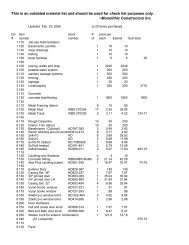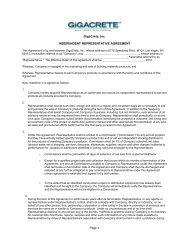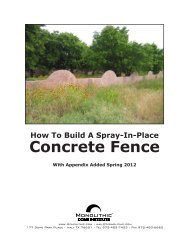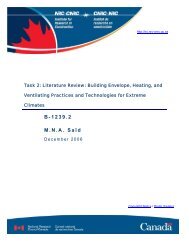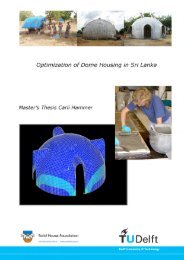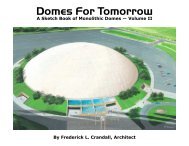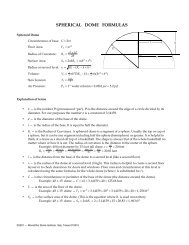Haws Village* Dukem, Ethiopia November 2008 - Monolithic
Haws Village* Dukem, Ethiopia November 2008 - Monolithic
Haws Village* Dukem, Ethiopia November 2008 - Monolithic
Create successful ePaper yourself
Turn your PDF publications into a flip-book with our unique Google optimized e-Paper software.
<strong>Haws</strong> <strong>Village*</strong><strong>Dukem</strong>, <strong>Ethiopia</strong><strong>November</strong> <strong>2008</strong>Contents:Executive SummarySite Plan and LocationHomes; Public and Commercial Centers DescriptionsConcept SketchesLeland Gray, NCARBBudgetField Study Notes by Wes <strong>Haws</strong>Thoughts on <strong>Ethiopia</strong> by Alyssa <strong>Haws</strong>Three Examples of Families Ready to MoveA Letter From A Factory Ready to Buy HomesDomes for the World | 230 E 300 S #901 | SLC, UT 84111 | rebecca@dftw.org*<strong>Haws</strong> Village is a working name for this project. The foundation which funds this development will have naming rights.1
Executive Summary“In the end, this community will raise enough money to fund our efforts in perpetuity.And when it does that, then we will prove that this model can be replicated in every city in<strong>Ethiopia</strong>, every country in Africa, and every continent in the world.”--Wes <strong>Haws</strong>, DFTW Lead SuperintendentOUR BUILDING SITE NEAR DUKEM, ETHIOPIAFACTORIES ACROSS THE WAY FROM OUR SITEThe need for low-cost, high-quality housing in <strong>Ethiopia</strong>is great. Because of the price of regular construction,few foreign investors are interested in building low-costhousing. The government is building some apartmentcomplexes, but not enough. In addition, many peoplemoving to the urban areas are used to owning land andfarms. Some families do not adapt easily to apartmentlife.The proposed development is located on the outskirts ofthe city of Addis Ababa, 15 miles from the city of <strong>Dukem</strong>.<strong>Dukem</strong> is the main city center for the area and has hadabout 30 factories built in the last year alone.The factories are planned to be completed and be in fulloperation within the next two years providing thousandsof jobs to the local economy.With no provisions for housing in this area those workerswill have to commute a minimum of 10 miles everyday. In<strong>Ethiopia</strong> this travel expense represents about 20 percent oftheir income.More importantly, the demand for housing will sharplyincrease in this area, and become a fertile ground for yetanother unplanned settlement that is not sustainable bothenvironmentally and economically.This proposal addresses this need, a community for thoserising up out of poverty and creating <strong>Ethiopia</strong>’s newmiddle class. This village will be built of low-cost, butbeautiful, safe, permanent and sanitary housing which willbe used as a model for <strong>Ethiopia</strong>.While addressing the immediate housing needs of thisspecific area the proposal also tackles the larger and2
more pressing questions of best practices in creatingcontemporary developments in <strong>Ethiopia</strong>. Urban migrationis happening at a rapid pace. Usually this is motivated bythe need to look for work and meet basic survival needs.The community is organized based on a settlement patternmore familiar to local neighborhoods which are generallycompact with very small spaces between buildings.Local settlement patterns have typically weavedbuildings dedicated to residential use with those for workusually separate by interior shared spaces. The proposeddevelopment expands on this settlement pattern whileintroducing a sensitive balance between a growing desirefor contemporary urban amenities and an environmentalresponsibility.The planned development will build a self-supportingcommunity from the ground up with 300 homes, acommercial hub, school, local clinic and a communitycenter.The residences will be constructed utilizing <strong>Monolithic</strong>EcoShell technologies. Each home is sited on an average50 square meters of land.Having homes located in close proximity to the residents’workplace and their children’s school would make thenew development economically sustainable. In addition,EcoShells require VERY little maintenance and areimpervious to mold, bugs and rot-- this will aid in keepingthe community stable.The development will be complete within a year frommobilization and is expected to recover 50 percent of theinitial investment money in the first year. In the best casescenario—which is also reasonable—it is expected thatmost or all of the homes will be sold to the factory owners,investors, and other cash buyers and recover all the moneyimmediately.Monies recovered will be returned to the Donor at a prearrangedrate and cap, the rest will be reinvested into moreconstruction with similar intent of providing thousands ofhomes in a sustainable environment. Many homes couldbe built because of the initial capital investment.SITE PLANSITE LOCATION3
Homes; Public and Commercial CentersHomes<strong>Ethiopia</strong>ns typically have large families. We need to strikea good balance between conservative land use and ourdesire to provide enough land to families so they can beindependent and even grow a garden, if they wanted.The pride of owning a single family home cannot beunderestimated. The Domes will be finished up with tilefloors, indoor plumbing and nice windows. This will be ahuge upgrade in lifestyle.This will be an open market for the sale of the homes. Wewill give priority to buyers in the following order:1. Cash buyers purchasing multiple houses (factoryowners buying housing for their workers)2. Individual cash buyers.3. Investors who are cash buyers looking for rentalproperty.4. Individuals that have a good down payment.5. Investors with a good down payment.6. Individuals with a small or no down payment.7. We will then use the rest as DFTW rental property untilthey sell.This system is a model for free enterprise, and it will work.This may mean that we only get to step 4 before all theunits are sold. This will allow us to recover all moniesquickly and reinvest in more housing—enough housingthat we will be able to serve all levels of buyers. In thelong run, thousands of families will be given high qualityhomes for years to come.Those who do not pay cash for the home will be givenaffordable payments with a 20 year term. We will request10 percent down with payments of between 30 to 40dollars a month.We intend to have and enforce a few covenants. Therewould be a monthly maintenance fee to pay guards,provide garbage and sewer, and to hire teachers to educatethe village.There will be incentives in place which will reduce themaintenance payment. There will be reductions formaintaining a garden year round; taking monthly classesfrom a master gardener; maintaining at least one fruit tree;attending a monthly nutrition meeting with the nutritionexpert; taking a monthly class by a public health instructorto discuss health and hygiene related issues; takingmonthly computer classes; volunteering in the canary oncea month; and maintaining their home to certain standards.Commercial CenterWe want to provide the community members a means ofindustry. The following structures are suggestions at thispoint. Input from all project leaders is welcome.Grocery storeHardware store with specific tools and supplies to maintainthe Domes.Computer electronic store/ internet café. Giving peopleaccess to the internet will make a huge difference in theirlives. An I.T. professional will teach weekly computer andinternet classes.Clothing storePharmacyStationary shop/copy centerOur office: To run the village, sell units, rent units, buildmore units, enforce covenants and pay utility bills.Restaurant: High quality food with a master chef who willteach a weekly nutrition class.Juice Shop: Very popular in <strong>Ethiopia</strong>Hotel: We know there will be a large number of touristswho will come to see the community. Some would love tostay the night in a Dome. Also the 30 factories in the areahire specialized employees for a short amount of time ona regular basis. This will include 10 Domes and 1 receptionDome.Cannery: We will provide 3 square meters of gardenspace for each family. We will also hire a full time mastergardener to teach the benefits of gardening and canning.The cannery will provide them with a means to keep theirfood in storage. This is unheard of in <strong>Ethiopia</strong> and could berevolutionary.Souvenir shopGreen house for starting plants for gardens and a shop tosell garden supplies and seeds.4
This commercial complex will be owned by DFTWand rented out. In the future we can sell them to shopowners; sell them to investors; start a community businessand that business could purchase them; encouragemicro-enterprises to move in; or we could keep thempermanently.Public ComplexThe public complex will be donated back to theGovernment in exchange for the land. It will include:1. A Medical Clinic with a full-time doctor2. A Government office building3. A School: This will be a school big enough for 600students. It will have 20 Dome classrooms, restroomDome, library and teacher’s lounge.4. Cultural Center/Meeting House/Social RecreationRoom used for meetings, cultural events, and storingrecreational equipment. Teachers will provide adulteducation classes in the following areas: nutrition,hygiene, gardening and computers. This will also storeequipment to service the soccer field, basketball andplayground.Government InvolvementThe government has agreed to provide the main powerline and transformer to the village. They will provide theroad up to the entrance of the villageThey will provide legal protection and enforcement of allcontracts, mortgages, and covenants made by DFTW.They will maintain all buildings donated to them in thePublic Complex.They will allow us to drill and install a well and provideus a small piece of land for a water tank on top of the hill.They will also allow us to control the water. We will be incharge of price setting and maintenance. There have beenhuge problems in the past with the government has takencontrol of water access and tripled the price.The objective of this water system is to give people plentyof water at a low cost to upgrade their lifestyle. They alsoneed enough cheap water to maintain a garden all yearround. DFTW will stay in control to make sure thesethings are done.The government will allow us to purchase cement, tile,sand and rebar direct from the factory and will ensuredelivery in a timely manner. All of our equipmentpurchased and shipped for this project will be free of allimport taxes and other taxes.SITE CONCEPT BY FASSIL ZEWDOU, GOJO HOMES, ETHIOPIA.FASSIL AND HIS SISTER ARE GOING TO BE EXCELLENTCOUNSEL. THEY HAVE HELPED US A GREAT DEAL TO PUTTHIS PROJECT TOGETHER.JIM KASLIK OF CLOUD HIDDEN DESIGNS PRESENTS THISCONCEPT SKETCH FOR CONSIDERATION.5
Design Concept by Leland A. Gray, NCARBWhen asked about his prior architectural career, whichhas included some 13,000 projects, Gray said, “I had adream job when I was the (LDS) church architect. It wasa highly sought after position. I had it for 25 years. Everyother church-member architect in the world wanted myjob.”When asked whether he had a “dream project” in mind,Gray said, “I’ve already built it: the LDS ConferenceCenter in Salt Lake City -- amongst many, many others Icouldn’t even list.” That Conference Center can seat morethan 21,000 (making it the largest performing arts centerin the world) and was designed to last 150 years.Five years ago, Lee Gray took an early retirement toform his own firm to focus on design and developmentof <strong>Monolithic</strong> Domes. Having a history in thin-shellconcrete construction as well as a close working friendshipwith David B. South, President of <strong>Monolithic</strong>, Inc., thiscareer path was the next logical step.During his presentation at the Ninth Annual <strong>Monolithic</strong>Dome Conference in 2005, Gray pointed out that despitethe Dome Industry’s progress, the general public stillperceives concrete thin-shell construction as an “alternate,less attractive building approach” rather than a “preferredmethod of construction.”His firm, LPDJ Architects, LLC. is changing all that. In<strong>2008</strong>, they designed and managed 100 Million USD inDome business.He is ready to help in any way to see DFTW projectsget built in every corner of the globe. His internationaldevelopment experience is indispensable to us.The drawings on the right are a concept Gray developedfor a school in Hawaii. The general idea would translateeasily to a holistic community anywhere in the world.6
Project BudgetCONFIDENTIALEngineering $9,900.00Supplies & Transportation $48,750.00Rough Grade Rental $8,000.00Airforms (5, 25 ft.) fans & shipping $28,750.00Office equipment, phone, internet, utilities $25,000.00Cement Mixers, Trowels, Shovels, etc. $20,000.00Temporary tents, kitchens for 400 workers $9,250.00Installation of Wells and Meters $144,250.00Electrical hookup w/ meters, panels and transformers $78,250.00Paths, sidewalks, retaining walls, landscaping, drainage $65,000.00Plumbing, septic system $75,750.00Fence $28,250.00Road, Gravel $44,500.00*Dome Homes @ $5,450 x 300 $1,635,000.00Superintendent Salary $78,750.00Assistant Salary $35,000.00Living Expenses $28,750.00Travel Expenses to and from US $24,500.00School $59,750.00Clinic $17,250.00Playground, basketball court, football field, cultural center $28,000.00Government building $11,500.00Commercial complex $236,000.00Contingency, 4% $109,606.00DFTW Administration Fee 7% $191,810.50Total: $3,041,566.50*Dome HOME COSTS:Shell $3,100.00Windows, Doors $500.00Coating $800.00Paint inside $100.00Tile $500.00Kitchen $300.00Electrical $150.00Total: $5,450.00PROJECTED RETURN ON HOME SALES:Dome Home Sales Cost$10,153.97 (or 99,000 <strong>Ethiopia</strong>n Birr)Homes Sales x 300 $3,046,191.006
Field Study NotesAn interview with Wes <strong>Haws</strong>, Lead Superintendent, DFTWHow did you feel before you left for <strong>Ethiopia</strong>?This was my second Trip to <strong>Ethiopia</strong>. My goals were clear.I had spent a lot of time in emerging countries and I havedone a lot of good things but when all was said and doneI didn’t feel like I did much. I had decided that the way Iwanted to make a difference was to not only find a way tobuild housing, but introduce new industry and enterpriseto a country. That is what made America great. So Iwent to <strong>Ethiopia</strong> partly to find something I could do toaccomplish this goal.How did you feel once you landed? What were your firstimpressions?As I looked and talked to people I realized that thereare more barriers to cross than just encouraging freeenterprise. Just as a I found out in Indonesia, anythingwe do in <strong>Ethiopia</strong> would be a delicate balance betweenbringing western ideas and ways of doing business andcombining them with their culture.The people are friendly and always have a smile. <strong>Ethiopia</strong>has the lowest crime rate in Africa and I immediatelycould see that in their calm demeanor. I know I will haveto be careful to tread lightly, being the type-A-get-it-doneperson that I am.Did you notice cultural similarities between the<strong>Ethiopia</strong>n people and the US?One big thing I noticed--and I know it seems obvious--but just like us, the people of <strong>Ethiopia</strong> have dreams. Theyhave been suppressed under communism and poverty butit has not diminished their dreams. Everywhere I lookedthey were reading books like “The Secret” and “7 Habitsof Highly Effective People”.As I talked with electrical contractors, plumbers, realtorsand businessmen, I saw a group of people ready to usetheir talents in a big way. When I talked about 300 homesand an all-inclusive development, I saw their eyes light upand I knew they were up for the challenge.There are people just waiting for an opportunity to shineand really do something big. In Idaho we don’t wait forour chance We go and take it. We have been empoweredto believe if we work hard enough we can achieve ourdreams. In <strong>Ethiopia</strong> they seem to be less sure, but they arewilling and excited to try.What was your initial purpose for the visit?I had four purposes on this visit.1. To visit the child I had fallen in love with on my first visit.Now my wife and I are working on adopting this boy. Weknow he is meant for our family.2. For me to expand the orphanage at Village of Hope bybuilding additional Domes.3. To allow my new wife to experience <strong>Ethiopia</strong> and dosome good together.4. To find a project which would earn some income forboth DFTW to re-invest into the country and that couldhelp the people to not just subsist, but to thrive.Where did you stay?We lived in the orphanage with the children. We cleanedout a closet and made it our room.What was it like to introduce Alyssa to the orphans?We love the Kids there. Sometimes we cry because wewant so much more for them. Most of the time we laughbecause you can’t help but be happy when you’re aroundthem. They are so full of love.What made you decide on this concept for a DFTWproject there?As I searched for a project I came across a town called<strong>Dukem</strong>. This town intrigued me because it lies just onehour from the capital city, Addis Ababa. As the countryhas developed, <strong>Dukem</strong> has become a place of Industry.They recently constructed over 30 Factories in the area butnothing else. As these factories begin to open the peoplewill flock to them as they will be some of the highestpaying jobs in <strong>Ethiopia</strong>.I have a good understanding of housing. I have built adevelopment in Indonesia and have my own properties inIdaho. I knew right away there was a great opportunity forhousing in this area.[My goal was] to finda project which wouldearn some incomefor both DFTW to reinvestinto the countryand that could helpthe people to not justsubsist, but to thrive.7
Field Study Notes, cont.An interview with Wes <strong>Haws</strong>, Lead Superintendent, DFTWWhat kind of research did you do after visiting <strong>Dukem</strong>?I decided the best way to see if a project was feasible wasto visit other developments in the area and talk to thepeople.I first found a realtor and had him take me around tosome homes being built in Debrazet. What I found thereamazed me. The “Developers” have no concept of the word“Development”. The houses were not layed out in anyorder. There were no roads. Power lines were scattered atrandom. No thought of drainage or septic.These homes were some of the fanciest in the area! Thequality of construction was terrible. They had upgradedfrom mud and sticks to mud and sticks with a layer ofconcrete on both sides. We went into a home underconstruction and one of the walls already had a huge crackin it. I looked up and there were sticks sticking out of theconcrete! The windows and roofs were all made of metal.Concrete had been splattered all over the “windows”. Itcould never be cleaned off properly.Crooked windows--doors that did not open right--everything in the “development” was a disaster. So, thenI asked the price tag of this newly constructed mess. Thisis what blew me a way: they were for sale for $23,000American Dollars! I could not believe it. As I thoughtabout this I knew I could build the same size home, ofhigh-quality, and sell it for HALF the price and still makeenough to reinvest in more construction.I started showing people the pictures of New Ngelepen,Indonesia-- a community of 80 EcoShells where I hadbeen the Superintendent of Construction. I casuallysurveyed and asked anyone who would answer howmuch would they pay for those 700 sq. ft. homes? I wasgetting answers like $32,000 USD. My lowest answer was$18,000.They saw the quality of the EcoShells through thepictures. When I told them I could build them a housefor about $10,000 USD (or 99,000 <strong>Ethiopia</strong>n Birr) andpay for all the infrastructure, they got very excited. I gotseveral verbal commitments from investors there whowould purchase them as rental property because theylooked so good.How do the locals feel about Domes and our developingtechnologies?They loved the Domes! The could see their quality. Ido believe it will be important to make the Domes asmodern, yet as conventional, as possible.What kind of dealings did you have with the government?We scheduled a meeting with the governor of that region.He was the equivalent of the governor of a state here. Isat down and told him of my ideas. He was very excited. Iasked him what it would take to get the land to build sucha project and he said it would be “no problem”. He wouldexpect something back and asked what I had to offer. Itold him I could provide a government building and aschool in exchange for the land. He agreed and asked if Icould start construction immediately.He told me of the troubles he is having with housing inthe country. He said they could not find investors thatwere willing to build low-cost housing because the profitswere not high enough.The foreign investors were onlybuilding high-end custom homes in Addis.He said the government could not keep up with thedemand. They build government apartment complexesthat are 400 sq. ft. per unit and cost 7,000 dollars. Theyrecently finished one in Shashameni that was 200 units.They had over one million people apply for this housing.How were the roads? What are the utilities available to<strong>Dukem</strong> that we could tie into?The road to <strong>Dukem</strong> is a good, standard American road.They have electrical service to tie into and sewer in<strong>Ethiopia</strong> is all done by pump trucks.What is your vision, if it could be as big as your wildestdreams, what would it be in the short term as well as inthe long term?I see a village that is self-sufficient. Shopping center,paved roads, electricity by solar and wind, advanced septicsystems, well-built homes with trees and gardens. Awhole package--better that anything seen in the country.And the best part is in the end this community will raiseenough money to fund our efforts in perpetuity. Andwhen it does that, then we will prove that this model canbe replicated in every city in <strong>Ethiopia</strong>, every country inAfrica, and every continent in the world.8
Thoughts On <strong>Ethiopia</strong>by Alyssa <strong>Haws</strong>, Public Health Expert and Executive Assistant, DFTWWes and I spent our honeymoon with an NGO called“Village of Hope” at their orphanage in <strong>Ethiopia</strong>. It islocated in the small village of Kersa Illala about threehours southwest of Addis Ababa.As soon as we arrived the kids showered us with love andunending attention. We quickly settled into a our cozy6x10 closet. There are 30 orphans who live there, rangingfrom newborn to 18 years old. Each has a unique story andpersonality.We were continually touched by their ability to rise abovetheir circumstance and move forward. We spent timeflying kites, blowing bubbles, telling stories, laughing andloving them. We have stories about rats in our bedroom,eleven days without electricity and water, and the strangetraditional foods we ate. All these priceless memorieswill be cherished forever. The children have captured ourhearts and changed our lives for the better.A Dream FulfilledSince I was young, I’ve dreamed of going to Africa. I’veschemed hundreds of ways to go and serve the people.Going with Wes was better than anything I had everimagined. While living in the orphanage, I taught at anearby school about HIV and AIDS. Teaching in theirmodest mud school rooms was humbling. It was rewardingto see their thirst for knowledge.In The LibraryThat same school had thousands of used books donatedfrom America to start their first library. The books hadbeen locked up in a dusty room for months because theydidn’t have the know-how to organize and categorizethem. My mom is a librarian, and I couldn’t let herdown. It was a massive project to tackle but well worth theeffort.Pearly Whites<strong>Ethiopia</strong>ns brush their teeth with a stick. There is a treewhich is specifically used for toothbrushes. Many itemswere donated for us to take on our trip. Among thoseitems were toothbrushes and toothpaste. It was humorousto see them brush with toothpaste for the first time.Omo ValleyVisiting the Omo Valley was remarkable. Two long daysof driving on treacherous roads was an amazing feat.The valley is filled with a mix of several ethnic groups.We felt like we were walking through a “NationalGeographic”. Before taking a picture, a price had to beagree upon to pay them. If they thought they were morebeautiful than the other villagers, they expected moremoney for their picture. They are very proud of whothey are and how they are living. It was incredible towitness their culture.Wes Building DomesWes has a great desire to serve people in largeways. His love for others has made a difference in manyparts of the world. <strong>Ethiopia</strong> was no exception. WithWes working by their sides, several Domes were builtby local workers. These Domes will be used to housemore orphans and one larger Dome for a Women’sEducational Center. These buildings will be a hugebenefit and blessing to those in the orphanage andsurrounding village. Wes also has an amazing capacityto love people on an individual level, especially littlechildren. Each child felt needed and special whilenear him. He made sure the money [we raised at ourwedding reception (in lieu of gifts)] was spent onplayground equipment, a basketball court, and a soccerfield with goals. The kids looked up to him and wereextremely sad when he had to leave.Lake LanganoOne of my favorite memories of our trip was our outingto Lake Langano. The weather was beautiful. We tookthe children to the nearby lake to go swimming. Wemade peanut butter and jelly sandwiches for everyone...they all thought they were gross.9
Story One:Amaha Melkesadik AragawAmaha Melkesadik Aragaw is a 30 year old iron worker who lives with his wife Aragash in a nearby town within the city limits of <strong>Dukem</strong>, some 40 kilometers away from the city of Addis Ababa,the capital of <strong>Ethiopia</strong>. Amaha left his beloved countryside near the town of Assala as afourteen year old boy to work as a laborer and was the youngest of five siblings. He met his wife,Aragash now twenty five, five years ago. Aragash is among a group of children who were raisedas orphan, along with some chaperones, made the then difficult journey to the city of Akaki, onthe outskirts of Addis Ababa to take her first work as laborer. There, Amaha met Aragash andsupported themselves with temporary jobs while going to local public school. They got marriedtwo years ago. Currently the couple has no children and lives in one room ‘hut’, 4meter by5meter. Learning more about the young couple, there is a sense that, in spite of the difficultcircumstances under which they live, their life is guided by a depth of purpose shared by many,young and old, in the community. Their desires are met by being focused and being purposefulthat started from their teen years.Amaha and Aragash are optimistic as they seek a better future in the town of <strong>Dukem</strong>, whereconsiderable industrial development is taking place. They are also hopeful to have some work inone of the manufacturing plants and secure a home to live nearby their employment place.They hope to better themselves and build a family and are willing to pay up to $500 in rent, or ifavailable, for mortgage payment with an initial down payment of $7000 for a new home withtwo bed rooms, as long as the home is near their work place in <strong>Dukem</strong>.
Story Two:Kawa Gudeta BedaneKawa Gudeta Bedane, age 48, is a father of six children. Kawa is married to Etenesh, andemployed as a guard in a nearby factory. Three of his children still live at home and juggleschool and work in alternate seasons to provide support for their family.Kawa’s and Etenesh’s childhood experience is formed in a town that did not change thatmuch—south of the Arisi region about 150 kilometers from Addis Ababa—the neighborhoodssimply become mini villages where people come together in the evening drinking theirhomebrew and share their dreams, hopes, sad stories, dance and rejoice that they know otherswith whom they might share and are known.The life of Kawa’s family is guided by vigor of his wife, Etenesh who is now age 36 and is focusedand determined to improving their family’s well being. Like her mother before her, Eteneshwanted to go into the workforce and do something meaningful for her family, but due to thehardship of long commute to where employment is readily available she chose to stay at homeas a homemaker. Etenesh is ready to work hard, to build her family and keep their childhooddream alive. Both Kawa and Etenesh look forward to provide their family an experience similarto their childhood growing up in an environment they can call home. Kawa envisions a home inthe town of <strong>Dukem</strong>, closer to his work which would save him his hard earned money.Currently, Kawa’s family live in a substandard house in the city of Akaki, 10 kilometers away fromtheir employment which is located in <strong>Dukem</strong>, and with no public transportation makescommuting difficult. At present, Kawa’s family pays $150 for rent. Kawa hopes to live nearby hisemployment place. He hopes to borrow from his relatives and invest $1,000 in down payment fora new home with two bed rooms, if provided near his work place in <strong>Dukem</strong>.
Story Three:Mulisa Beyene EdeMulisa Beyene Ede is a 48 year old factory guard who lives with his wife and four children on theoutskirts of the city of <strong>Dukem</strong>. Mulisa was born and raised in this region where at age 30 met hiswife eighteen years ago and since supported his family with a job as a security guard. His wife worksat home preparing food for passerby. They live in a house that is typical in that community withoutelectricity, no water, and other facilities we take for granted. Yet, in spite of it all, Mulisa’s familysees a better future–-surrounded by industrial developments, they hope to secure a house and ajob in <strong>Dukem</strong>.Mulisa hopes to be employed as a guard in one of the manufacturing plants and to live nearbyhis employment place. He also hopes that his young children may be able to secure a job in anearby factory and improve the conditions of their life and build a family. Mulisa is willing to payup to $200 in rent. If home ownership is available he would be able to afford an initial downpayment of $5000 for a new home with two bed rooms, as long as the home is near their workplace in <strong>Dukem</strong>.



